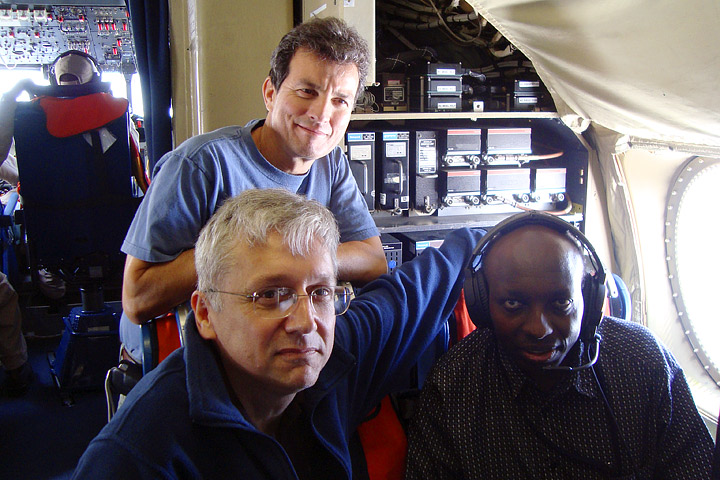

Lidar, radar, visible-light imagery, ground surveys, and computer models all bring slightly different answers to the same problem. Three different teams produced three different forest and carbon maps in a fifteen-month span. Groups at Stanford, the European Space Agency, Brazil, the U.S. Forest Service, and dozens of other institutions are pursuing similar questions, sometimes as competitors, sometimes as collaborators.
From a distance, the research can sometimes appear redundant. But parallel approaches and competition have always been the recipe for innovation and deeper understanding.

David Harding (left), Charles Gatebe (right), and Rafael Rincon (back) were three of the lead scientists on the Eco 3D field campaign. Each of the researchers was responsible for a different instrument. Understanding of the world’s forests is improved by multiple groups looking at the problem from varying perspectives. (NASA photograph courtesy Jon Ranson, GSFC.)
“It’s similar to cancer research, where you have different laboratories and different countries pursuing the same problem,” said Jon Ranson. “Everyone is looking with a slightly different angle and methodology. Groups are collaborating as much as they can, and taking the data that are available and making the best of it. In the end, it’s complementary and it improves the overall science.”
The ultimate prize is a uniform, standardized map of forest heights and carbon stocks on all continents at one time. And that map should be updated and revised as human activities renovate our planet.
“We have a pretty good handle on forest area worldwide, but not as great a sense of the structure or the changes,” says Steve Running, a member of the Intergovernmental Panel on Climate Change. “We need a better global, annual measure of our carbon stocks. We need to know how things change each year through fire, new growth and re-growth, desertification, and deforestation.”
“How do we cover the whole world,” Running adds, “and do it every two to three years, which is what the science needs?”
The number of options for space-based mapping has gotten smaller. The ICESat mission ended in 2009. Its follow-on, ICESat II, is slated for launch in 2016, but will not necessarily be able to view forests in the same way as its predecessor. The synthetic aperture radar used for the Shuttle Radar Topography Mission provided a global picture of Earth’s landscape structure in early 2000; but the space shuttle was retired in July 2011. A similar technology could provide forest structure and cover globally every year if launched on the space station or another satellite.
Many forest researchers and ecologists were counting on a mission that was proposed years ago and recommended by the National Research Council in 2007—the Deformation, Ecosystem, Structure, and Dynamics of Ice satellite. DESDynl would combine radar and lidar technologies to get a three-dimensional view of forests and their carbon stock. But that mission was put on indefinite hold in the spring of 2011 as the U.S. government made deep budget cuts. Researchers are now looking for other means to fly those instruments in space.

NASA researchers use instrumented aircraft—such as the P3 Orion—to make measurements that supplement and bridge the gap between satellite missions. (NASA photograph courtesy Jon Ranson, GSFC.)
Ranson and colleagues Doug Morton, Bruce Cook, Ross Nelson, and others at NASA Goddard have picked up the effort to find a way forward. Since August 2011, they have been flying developmental instruments on NASA research airplanes, crisscrossing the eastern United States and taking stock of everything from sub-tropical wetlands to boreal forests. The team has been flying over Forest Inventory and Analysis plots in Maine, New Hampshire, Pennsylvania, Maryland, Virginia, North Carolina, and Florida, while flying under the old satellite tracks of ICESat. The team intends to calibrate their data against measurements from ICESat, Cook says, “and see if we can detect changes as we re-fly over an area.”
In the summer of 2011, Ranson led the Eco-3D mission to measure forests in the eastern U.S. and Canada with three main instruments—radar, lidar, and a radiometer. The Digital Beamforming Synthetic Aperture Radar (DBSAR) provides a broad, horizontal view, distinguishing forest from other land cover and giving a sense of the biomass density. The Slope Imaging Multi-polarization Photon-counting Lidar (SIMPL) measures the forest canopy height and structure, while also providing clues about the types of trees being measured. The Cloud Aerosol Radiometer (CAR) measures the light reflecting properties of the leaves and landscape, which tells researchers about the composition and health of the forest.

Lidar instruments measure tree height by bouncing laser light off the canopy. (NASA image by Robert Simmon.)
Beyond Eco-3D, the Goddard team has been working with partners in Canada and Brazil to improve airborne forest mapping, which may be the best method the world will have until a space-based lidar and radar can be flown again.